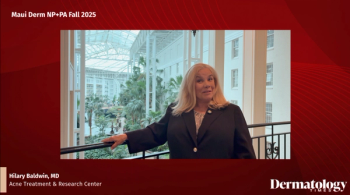
- Dermatology Times, September 2020 (Vol. 41, No. 9)
- Volume 41
- Issue 9
Pathophysiologic pathways provide treatment efficacy insight
Experts offer insights into the inflammatory pathways involved in rosacea pathogenesis, the putative anti-inflammatory mechanisms of action of treatments for rosacea, and future therapeutic needs.
Knowledge of the inflammatory pathways that are operative in rosacea and the putative mechanisms of action of existing modalities indicated for treating inflammation-related signs and symptoms of rosacea provides a basis for understanding the limitations of current treatments and identifying potential targets for achieving better outcomes, says Jerry Tan, M.D., adjunct professor of internal medicine and dermatology, Western University, London, Ontario, Canada.
In a recently published article, Dr. Tan, together with J. Mark Jackson, M.D., clinical professor of dermatology, University of Louisville, Louisville, Ky., undertook a review of the complex inflammatory processes of rosacea and the spectrum of topical and systemic agents used as anti-inflammatory treatment with a focus on the potential mechanisms of each therapy.1
READ
“Our hope in doing so was to understand current gaps and identify opportunities for interventions that might better help patients with the various presenting features of rosacea,” Dr. Tan tells Dermatology Times.
“From our review, we concluded that there are no regimens available that confer long-term relief of erythema, remission of papules and pustules in large proportions of those affected, or reduced risk of progression to phymatous changes. These limitations indicate an unmet need for more efficacious treatments that can address the inflammation that gives rise to most signs and symptoms of rosacea and that will offer patients the possibility of complete clearance.”
Multifactorial pathogenesis
Discussing the pathophysiology of rosacea, Drs. Tan and Jackson note that prior research has identified four converging inflammatory pathways: 1) activation of innate immunity via toll-like receptor 2 (TLR2); 2) protein activated receptor 2 (PAR2); 3) inflammasome activation; and 4) transient receptor potential (TRP) channels. These pathways are described in more detail in the body of the article and outlined graphically.
The latter figure identifies the common exogenous and endogenous triggers for each of the contributory inflammatory pathways. In addition, it summarizes their signal transduction pathways, including the cellular and molecular participants, illustrates how they translate into various pathological features of rosacea (ie., vasodilation, angiogenesis, inflammation/neurogenic inflammation, fibrosis), and shows the downstream phenotypic signs and symptoms of rosacea (ie., erythema/persistent erythema, flushing, telangiectasia, papules/pustules, phymata, heat sensation, edema) that are associated with the various pathologies. The figure also identifies the therapies that have mechanisms of action specific to each pathway.
Dr. Tan points out that erythema developing as a consequence of vasodilation or angiogenesis is a feature of rosacea that is common to the activation of all four pathways.However, specific pathway activation may lead to specific presentations, suggesting the possibility of personalizing treatment selection if clinical features or biomarkers can be identified that indicate which pathways are dominant in the individual
“As an example, activation of the TRP channels leads to transient and fixed erythema, but it does not lead to the development of papules/pustules. Presence of the latter inflammatory lesions may be more representative of activation of the TLR2, PAR2, and inflammasome pathways,” he explains.
As mentioned in the article, there may also be crosstalk between the four pathways that can perpetuate a loop of inflammatory responses and progression of the phenotypic features of rosacea in some patients.
Treatment review
The section on anti-inflammatory treatments for rosacea summarizes information for both products that have regulatory agency approval for use in rosacea and for commercially available modalities that are used off-label. Included in the discussion are efficacy results from clinical trials, available data from preclinical and clinical studies relating to effects on inflammatory mediators, and efficacy results from clinical trials investigating combination regimens using oral subantimicrobial doxycycline and various topical agents.
In addition, the article provides a brief overview of emerging treatments. The latter include topical minocycline foam, which was recently approved by the FDA, and several that are in clinical trials, including encapsulated 5% benzoyl peroxide cream; topical antimicrobial peptide gel (Omiganan); the proteasome inhibitor ACCU-D1; extended release, low-dose oral minocycline (DFD-29); rifaximin; a topical formulation of beneficial ammonia oxidizing bacteria (B244); and the human interleukin-17A antagonist secukinumab.
Future needs
Offering their perspectives on future needs in the treatment of rosacea, Drs. Tan and Jackson identify the importance of long-term studies that can provide insights on predictive factors for risk of developing inflammatory lesions and/or phyma and whether early intervention for erythema mitigates progression. They also highlight the limitations of existing treatments and describe some features of “ideal” therapies that address the underlying inflammatory pathways of rosacea while avoiding unwanted side effects.
Disclosure:
Dr. Tan and Dr. Jackson have been an advisor, consultant, investigator, and/or speaker for companies that market treatments for rosacea.
Reference:
1 Tan J, Jackson JM. J Drugs Dermatol. 2020;19(6):585-591
Articles in this issue
over 5 years ago
Will OSHA cite me for requesting employees not wear masks?over 5 years ago
How safe are cosmetics?over 5 years ago
Pretreatment punch technique guides safe injectionover 5 years ago
What we know (and don’t) about dietary effects on skin agingover 5 years ago
Microbiome-based treatments not ready for prime timeover 5 years ago
Emerging options for high-risk melanomaover 5 years ago
Phenotypes inform management optionsover 5 years ago
AI has potential to improve melanoma detectionNewsletter
Like what you’re reading? Subscribe to Dermatology Times for weekly updates on therapies, innovations, and real-world practice tips.

















